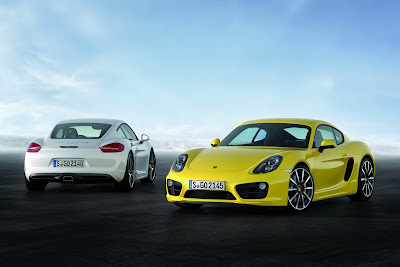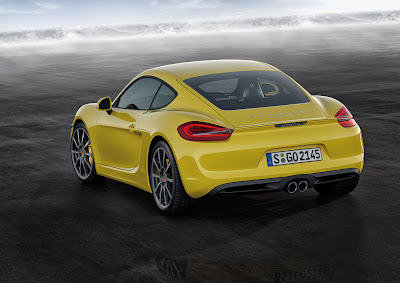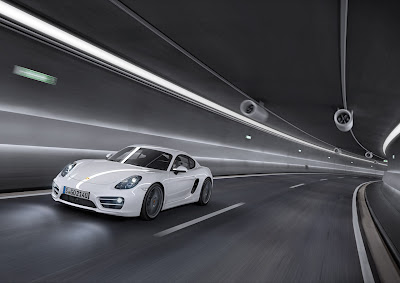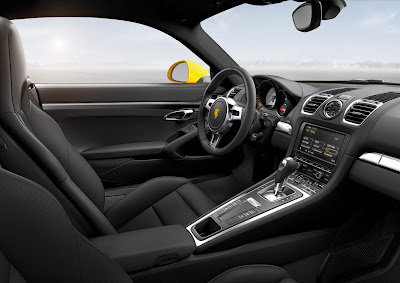It is built for driving through bends like few other sports cars can: the new Porsche Cayman sets new standards in its class for driving performance with a longer wheelbase, all-round new chassis and lower weight. The two-seater, newly developed from the ground up is - after the 911 Carrera and Boxster - the third sports car model series from Porsche to feature innovative lightweight body design.
The new Cayman is up to 30 kg lighter, depending on the specific model and equipment, and it consumes up to 15 per cent less fuel per 100 km than the previous model - despite higher engine and driving performance.
2014 Porsche Cayman
2014 Porsche Cayman
2014 Porsche Cayman
2014 Porsche Cayman
2014 Porsche Cayman
Porsche is also upgrading the Cayman with new optional features. For example, the sport coup� is now available with Adaptive Cruise Control (ACC) for the first time which controls the distance to the car ahead in traffic and vehicle speed, as well as a specially developed Burmester sound system. Another new feature for the Porsche Cayman is the optional Entry & Drive keyless system that can be factory-installed.
Design: New proportions, prominent lines
The new Porsche Cayman is more distinctive than ever. Its proportions are new, and yet it is clearly a Porsche sport coup�; an extended wheelbase with shorter overhangs and 18- and 19-inch diameter wheels with larger rolling circumference are identifying visual characteristics of the car's more enhanced driving performance. Its styling is marked by precise lines and razor-sharp sculpted edges. They emphasise the car's low, extended silhouette with the windscreen shifted forward and the roof line that reaches far back. Typical of the more advanced styling is the shoulder line, which runs from the wings - which flare strongly upwards - towards the rear side panels. The door mirrors are now positioned near the top shoulder. Especially expressive and characteristic are the dynamic recesses in the doors, which guide induction air into the distinctive air scoops on the rear side panels and then directly to the engine. This offers the most prominent visualisation of the basic concept of the mid-engine.
From the front end, the new Cayman is marked by its dominant cooling air inlets, which increase in size towards the sides of the car. Integrated in them, far outboard, are the round front lights with four-point daytime running lights or position lights, an unmistakable identifying feature of the new Cayman. Just as unique to the new generation of the sport coup� are the large, low rear lid made of aluminium and the rear section with its wrap-around edges. At the upper end of the rear window, an LED brake light spanning the entire window width warns traffic behind. Mounted directly to the rear lid is the thin blade of the rear spoiler, which - in contrast to that of the Boxster - is higher and deploys at a steeper angle. The overall appearance of the Porsche Cayman is more independent than before, and it is well-differentiated from the previous model.
Six-cylinder with high-revving concept: the heart of an athlete
Porsche is implementing two exceptional sport engines in the Cayman, which combine ample torque with high power in the upper engine speed range. One consequence of this high-revving concept is that it enabled a 0.2 litre reduction in base engine displacement compared to the previous model, and yet it has a higher power output.
With its specific power of 101.6 hp/litre, the 2.7-litre engine is the first Cayman to break the magic 100 hp per litre displacement barrier for sports car engines. Both engines now produce their maximum nominal power at 7,400/min; it was 7,200/min previously. Not only were peak powers increased by 10 hp to 275 hp (202 kW) in the Cayman and by five hp to 325 hp (239 kW) in the S-model; their two power curves also lie above those of the previous engines, which means that overall the six-cylinder engines produce more power at identical engine revs.
The new engines induct their air from the left and right air scoops. In the 3.4-litre six-cylinder engine of the Porsche Cayman S, a switching resonance flap improves cylinder fill, providing high torque at low revs as well as a uniform torque curve. Both engines feature variable valve timing and lift (VarioCam Plus) on the intake side for optimal timing in charge changes.
Intelligent efficiency: Electrical system recuperation, thermal management, coasting function
The flat-six cylinder engines - positioned in front of the rear axle - make the two-seat Porsche cars prime examples of efficient performance. The engines of both models are up to 15 per cent more fuel-efficient due to their petrol direct injection, thermal management, electrical system recuperation and auto start/stop function.
Key components for improving efficiency are electrical system recuperation and map-controlled thermal management of engine cooling. In electrical system recuperation, the battery is charged more intensively during braking and coasting phases. In turn, alternator charge current can be reduced when the battery is fully charged.This reduces the load of the internal combustion engine in acceleration phases, because it does not need to output as much power to charge the battery. Thanks to intelligent control of the combined engine and transmission cooling systems, both engines reach their operating temperatures more quickly, which results in better combustion under part-load with less friction.
In conjunction with the PDK transmission, the new Cayman shares a feature with the Boxster and the 911 Carrera that follows the principle of generating engine power only when it is actually needed: the coasting function. The coasting function enables decoupled coasting, in which the engine runs in neutral with low fuel consumption. In practice, this results in optimal savings of up to one litre fuel per 100 km with an anticipatory style of driving. In practice, this results in optimal savings of up to one litre fuel per 100 km with an anticipatory style of driving.
Standard six-speed manual transmission, PDK is an option
The transmission is also crucial for driving performance, comfort and fuel economy. In the new Porsche Cayman models, a standard six-speed manual transmission is employed; its gear ratios are optimally laid out for the engine's unique characteristics. The Porsche Doppelkupplungsgetriebe (PDK) is also available as an option. It offers seven gears and shifting without any interruption in propulsive power, and it enables faster sprints and better fuel economy.
The new Cayman models now offer a Sport button as standard that lets the driver choose between sport-oriented tuning and comfortable tuning that is optimised for fuel efficiency. In Sport mode, the electronic engine management system makes the engine respond even snappier, with more direct dynamic response of the engine. In vehicles with PDK, automatic mode results in later upshifts and earlier downshifts. Moreover, the start/stop function and coasting function are deactivated.
The PDK is precisely tuned to the vehicle dynamics of the new Cayman. An example: in manual mode, it enables controlled drifts with the Porsche Stability Management (PSM) deactivated - assuming a suitably protected roadway. Detection of the yaw angle and steering input angle initiates prevention of upshifting and permits this very special kind of driving fun.
Option: Sport Chrono package with dynamic transmission mounts
The optional Sport Chrono package offers a very wide spread of gear ratios ranging from sporty tuning - e.g. for circuit courses - to ride comfort in everyday use.It also includes dynamic transmission mounts. It delivers the best possible drive-off acceleration in conjunction with PDK and the Sport Plus button with the Launch Control function. This shortens the sprint from zero to 100 km/h by 0.2 s compared to normal mode. The Sport Plus button also activates the PDK "race course" shifting strategy. For even better driving performance and ride comfort, the Sport Chrono package provides dynamic transmission mounts. They alter their stiffness and damping as a function of the specific driving situation. With a hard setting of the mounts, for example, the drivetrain's moment of inertia is significantly reduced when steering into a bend and in quickly alternating bends, which minimises rear body press. Its effects are similar to those of motorsport cars, in which the engine is rigidly mounted to the body with bolts, resulting in more stable and precise handling.
New chassis system for even better handling
The driving performance of the Porsche Cayman is extraordinary. More than ever, the interplay of the mid-engine concept and chassis tuning assures it the top position in its class. The fundamental geometry creates ideal conditions for this performance: a 60 mm longer wheelbase for greater stability at very high speeds, a wide track width at both axles for additional driving stability and agility in bends and larger diameter tyres for even better road grip up to the limits of performance.
Porsche engineers placed high priority on tuning of the Cayman's chassis, but not only with the goal of improving driving performance and agility, but to simultaneously improve comfort and everyday practicality as well.
Revised PASM with extended sensors
The new generation of the optional PASM active damping system extends the driving performance range of the Cayman more sustainably than ever. The reason: four additional vertical sensors at the front and rear wheels enable even better and more finely tuned control. Optimally controlled damping improves the vehicle's road grip, offering greater driving stability, more comfort, enhanced performance and shorter braking distances. Just as before, the driver can use the PASM chassis control button on the centre console to choose between the two modes "Normal" and "Sport". The system also acts as a function of the specific driving situation, so that driving fun is not compromised: in smooth motorway driving, for example, only moderate damping forces are required. In a sporty style of driving, on the other hand, high damping forces improve road grip and car body control.
Quick and efficient reactions: two versions of electromechanical steering
Electromechanical power steering is also replacing the previous hydraulic system in the Porsche Cayman. Its high performance lets drivers experience the agility of the Cayman even more intensively. At the same time, the new system offers fuel economy benefits compared to conventional steering, reducing fuel consumption by at least 0.1 l/100 km. It also enhances comfort and safety through auxiliary functions. The driver gets direct feedback via the steering wheel, and negative or unnecessary noise is filtered out.
As an option, the power steering "Plus" version of electromechanical steering can be ordered, which enhances steering comfort with extra power assist up to 50 km/h. Parking and manoeuvring in particular are more smooth and comfortable - with lower steering forces. This system improves steering torque and steering wheel return to centre position at lower vehicle speeds.
More traction, better vehicle dynamics in bends: Porsche Torque Vectoring
Building upon the capabilities of the PASM chassis, the optional Porsche Torque Vectoring (PTV) system is able to increase the driving performance potential of the Cayman even further. PTV is the intelligent interaction between the rear differential lock with braking interventions on selected wheels, an added function of Porsche Stability Management (PSM). Essentially, PTV improves the vehicle's steering response and steering precision by targeted brake interventions at the rear wheel located on the inside of a bend. The braking torque is activated as soon as the steering wheel is turned. The results: improved performance in bends as the turn is initiated. Then the rear differential lock significantly improves traction capabilities when accelerating out of the bend.
Brakes with extra power
Because of the car's enhanced driving performance, the brake system of the Cayman has been made more powerful as well - that goes without saying at Porsche. Along with equipping the system with stiffer front brake callipers, optimising brake pad design and providing a larger brake contact surface, improvements were made in cooling the brake discs as well. Furthermore, the new Porsche Cayman S has larger front brake discs that originate from the 911 Carrera. To improve safety in traffic and provide a better warning to vehicles behind, the brake lights of all Cayman models pulsate as soon as ABS control is activated. As in previous models, the exceptionally high-performance Porsche Ceramic Composite Brake (PCCB) system is available as a motorsport-proven option. With this system, 350 mm diameter brake discs are used at the front and rear wheels of all models. The PCCB brake callipers are also painted yellow, and a new six-piston calliper from the 911 Carrera is used at the front wheels.
Larger wheels, low rolling resistance tyres
The new Cayman models ride on wheels and tyres that are now one inch larger in diameter than on the previous model. Standard now are customised 18- and 19-inch Porsche Cayman wheels, which give the sport coup�s better lateral stability and handling properties. Optional wheels for the new Cayman include the alternative 20-inch Carrera S wheels, 20-inch Carrera Classic wheels in bi-colour look and the new 20-inch Sport Techno wheels from the Exclusive programme. The standard tyres are optimised for low rolling resistance, they feature a typically high level of Porsche performance in terms of handling and braking distance, and they are low in weight. A seven per cent reduction in rolling resistance compared to the previous models contributes towards reducing fuel consumption.
Lighter, stiffer, sportier
The body of the new Porsche Cayman is an entirely new development based on the body-in-white of the Boxster. The results: The bottom line is that innovative lightweight body design with mixed aluminium-steel construction has reduced body-in-white weight by around 47 kg. At the same time, the car's static torsional rigidity was boosted by 40 per cent. In other words, the Cayman drives more precisely than ever before.
Extra features, larger glass surfaces and larger wheels offset some of the weight savings, yet the DIN weights of all sport coup�s are lighter than those of previous models, and a standard Porsche Cayman S weighs 30 kg less.
In its new lightweight body design, Porsche only uses steel where it is essential. On the other hand, wherever lightweight metals can be used, they are the preferred choice. For example, die-cast aluminium, aluminium sheet, magnesium and high-strength steels are used, and all materials are tailor-made for specific purposes in the body, ensuring very high rigidity values while minimising material usage. Around 44 per cent of the new Cayman body-in-white consists of aluminium, e.g. the front body, floor and rear body, the doors and the front and rear bootlids.
Compared to the previous model, aerodynamic lift was further reduced at both axles, which leads to greater driving stability at high speeds. Among other features, a new front spoiler lip significantly reduces front axle lift. At the rear axle, the new rear wing combined with a spoiler lip running across the entire width also makes a crucial contribution towards reduced lift. The wing is optimally integrated in the rear body with a curved shape, and it can be deployed either automatically or manually. With its 40 per cent larger effective area, it generates more groundforce than the spoiler of the previous model, and it offers less resistance to the air flow.
Elegant ambience, new high-class options
The interior of the new Porsche Cayman continues along the lines of current Porsche sports car design and adds value to the sport coup�. In its new optional features as well: for the first time, a high-end Burmester sound system can be ordered which is individually tuned for the Cayman. Other new and optional features that overcome class boundaries are Adaptive Cruise Control (ACC) and the keyless Entry & Drive system.
An especially exclusive ambience is created by the optional bi-colour leather packages that can be delivered; the base colour agate grey may be combined with lime gold, gravel grey or amber orange.
The centre console that ascends towards the front with its motorsport-like high-set gear shifter gives the driver the feeling of being more fully integrated in the interior. Controls for key vehicle operation functions and settings are arranged in logical groupings on the centre console. They are laid out for quick and intuitive control of individual functions.
New ergonomics support sporty driving
The new ergonomics of the Porsche Cayman and its more precise shifting now offer drivers even better conditions for quick and effortless gear shifts. The ascending centre console and the driver's seat position ensure a short distance between the steering wheel and the gearshift lever. The new gear indicator in the tachometer shows which gear is engaged, and the upshifting recommendation in the instrument cluster gives the driver feedback on a style of driving that optimises fuel efficiency.
The standard CDR audio system with its seven-inch touchscreen that is centrally located further upwards is very easy to see and offers convenient access to many different functions. The three classic round instruments of the Cayman model series with a centrally positioned tachometer and an ignition switch to the left of the steering wheel make the connection to a familiar cockpit environment. New is the high-resolution 4.6-inch VGA multifunction screen in the instrument on the right. Along with the most important trip computer functions, it also includes a map display for the optional PCM with navigation module.
The driver and passenger sit on new sport seats. They offer very good comfort for long-distance touring and very good lateral support for a dynamic style of driving. The standard sport seats have mechanical fore-aft and height adjustments, and the backrests are electrically adjustable. The optional sport seat plus system offers even greater lateral support with larger side panels on the seat cushions and backrests and more pronounced sculpting in the shoulder area. Electric sport seats and adaptive sport seats plus are still offered as options - and both include a memory function.
The car's new extended silhouette also increases the practical utility of the Cayman: the larger rear lid offers better access to the rear bootspace, and cargo capacity of the two-seater has been increased by 15 litres to 425 litres when loaded to the roof. An eye-catching feature that is revealed when the rear lid is opened is the new aluminium panel that extends across the engine compartment cover between the two filler caps for coolant and oil. A luggage partition bar that is also made of brushed aluminium laterally spans the space behind the head restraints.
New sound experience: Porsche Cayman introduces Burmester sound system to the class
The new top option among the sound systems is a special "made in Germany" system that Porsche developed for the Cayman together with Burmester. Based on experience acquired from systems in the Panamera, Cayenne and 911 Carrera, this new system attains a total acoustic power and sound quality that are excellent for the sports car segment. This is impressively demonstrated by the system's performance figures: twelve individually controlled loudspeakers, including an active "body-in-white" subwoofer with a 140 mm diameter diaphragm and integrated 300 Watt Class-D amplifier, and twelve amplifier channels with a total output power of over 800 Watt.
Greater comfort and safety: ACC with Porsche Active Safe
For Cayman models with Doppelkupplungsgetriebe (PDK), Porsche now offers a new upgrade option for driving convenience and safety: Adaptive Cruise Control (ACC) that includes the safety function Porsche Active Safe (PAS). ACC operation is based on a radar sensor located in the middle of the front body panel, which acquires objects in the driving lane over a range of up to 200 metres. ACC maintains a speed-dependent distance to a vehicle ahead in traffic over four preselectable stages, and it automatically adjusts driving speed up to a vehicle stop. This relieves the workload of drivers in traffic jam situations and in slow-moving traffic.
PAS builds on this system and can help to avoid front-end collisions - even when ACC is switched off. It uses the front radar system to continually monitor traffic for much slower vehicles ahead. If the system detects an impending hazardous situation, the brake system is preconditioned, and the brake assistant is sensitised. If the situation becomes more critical, PAS outputs visual and acoustic warnings, and the driver is alerted to the need to intervene by a jolt in the brake pedal. If the driver does not react with appropriate braking, the system can increase braking pressure up to hard braking, depending on the situation.
Driving without car keys: Porsche Entry & Drive
Porsche Entry & Drive is being offered for the first time in the class of the Porsche Cayman. The system enables keyless and convenient unlocking and locking of the doors and bootlid as well as engine starting. As soon as the driver touches the door handle, the Porsche Entry & Drive queries an access code that is saved in the key. If it is correct, the door is unlocked. Similarly, when the driver approaches the sensor zone at the front or rear of the car, the boot lid in that zone is unlocked and can be opened.
Technical Specifications
Porsche Cayman - 2.7-litre flat-six cylinder engine with 275 PS (202 kW); rear-wheel drive, six-speed manual transmission, optional seven-speed Porsche Doppelkupplungsgetriebe (PDK); acceleration from zero to 100 km/h in 5.7 seconds, with PDK in 5.6 seconds (5.4 seconds with Sport Chrono package); top speed 266 km/h, with PDK 264 km/h; fuel consumption (NEDC) 8.2 l/100 km, CO2 192 g/km; with PDK 7.7 l/100 km, CO2 180 g/km.
Porsche Cayman S - 3.4-litre flat-six cylinder engine with 325 PS (239 kW); rear-wheel drive, six-speed manual transmission, optional seven-speed Porsche Doppelkupplungsgetriebe (PDK); acceleration from zero to 100 km/h in 5.0 seconds, with PDK in 4.9 seconds (4.7 seconds with Sport Chrono package); top speed 283 km/h, with PDK 281 km/h; fuel consumption (NEDC) 8.8 l/100 km, CO2 206 g/km; with PDK 8.0 l/100 km, CO2 188 g/km.
Articles Source : NetcarShow





No comments:
Post a Comment